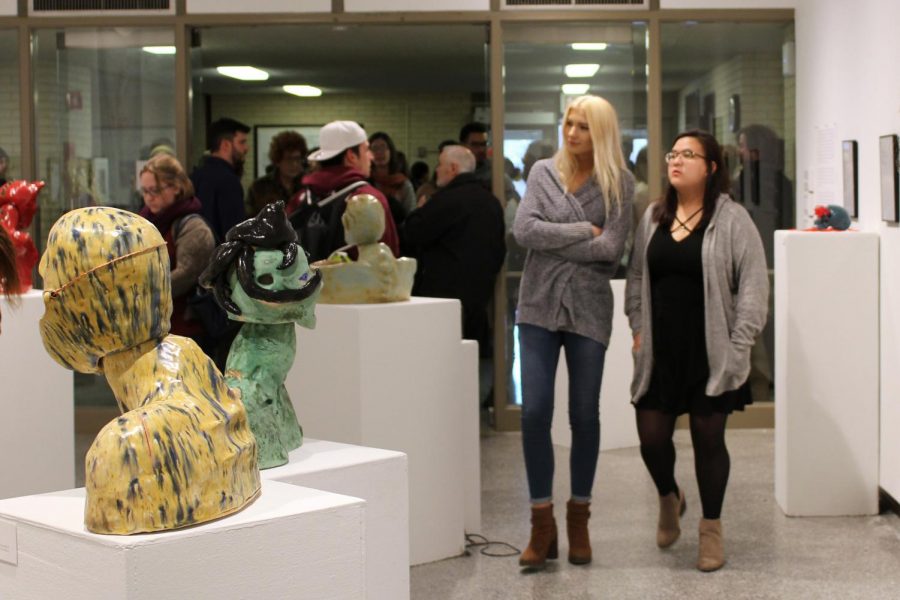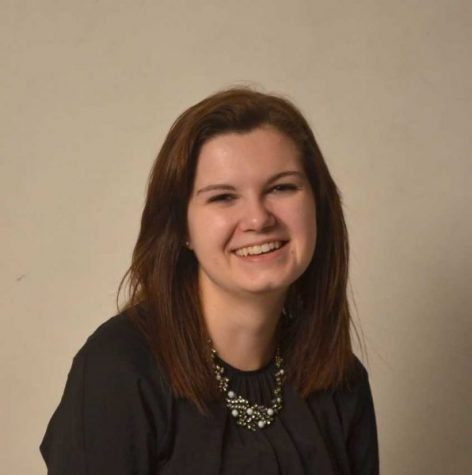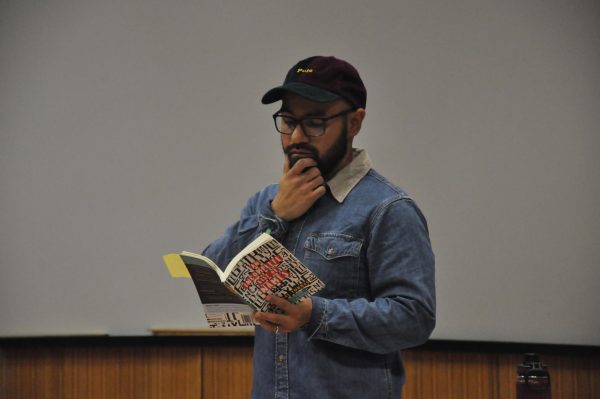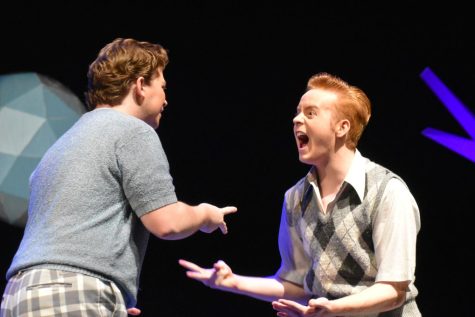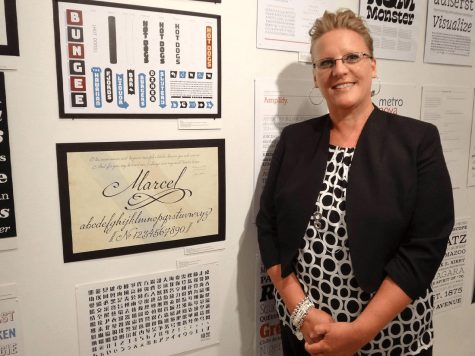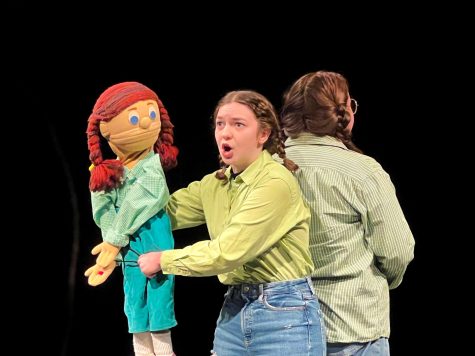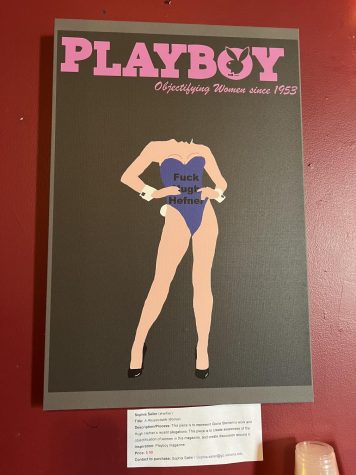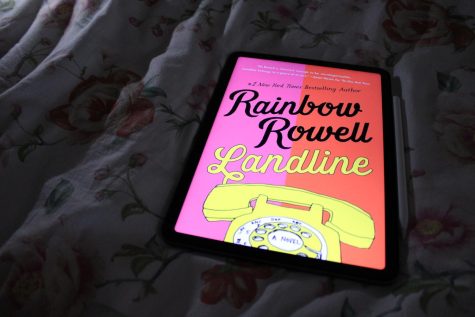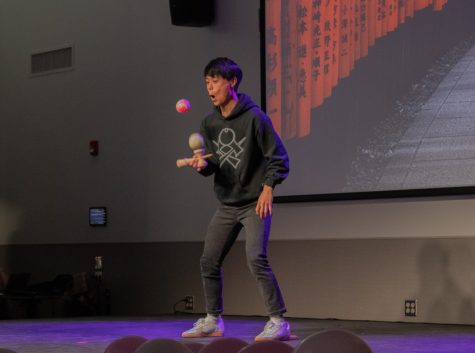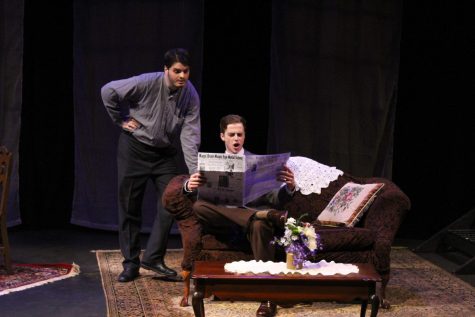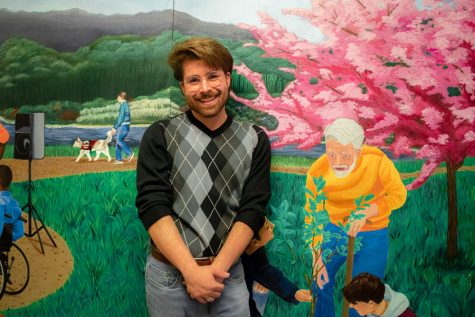Frankenstein bicentennial ends with a bang
Community members stroll around Watkins Gallery on Thursday, March 29 to view artwork and poetry created by Winona State students for a gallery titled “Exquisite Cadavers & Monstrous Constructions” that features corpse-esque art created to celebrate Mary Shelley’s Frankenstein.
April 4, 2018
Winona State University concluded the bicentennial celebration of Mary Shelly’s “Frankenstein” with two events featuring creative works from students and community members on Thursday, March 29.
The first event was a celebration of creativity and included awards for creative writing, ceramics and filmmaking. There was also a poetry reading by English professor James Armstrong’s advanced poetry writing class.
The celebration of creativity started out by Armstrong announcing the winners of the Frankentales, a short story contest. The contestants were required to write a four-page fiction piece that was an adaptation of “Frankenstein.” Ashley Gettes won first place for her tale “Resurrect,” which was an adaptation that took place in a Renaissance era. Adam Frederick won second place for his tale “Frankentale,” which was about a Frankenstein tale that took place in the Winona area.
Gettes and Frederick both read their stories before Ann Plummer, art professor, announced the ceramics winner.
One of the exhibits in Watkins Gallery is Monstrous Creations, where Plummer’s ceramics class created their idea of a monster out of clay. Brittany Huston won first place for her ceramic piece.
Armstrong’s poetry class also read their poems that were based off of monsters before the final awards were given.
Paul Johnson, film professor, concluded the awards by announcing the winners for the “Frankenvids.” Students were able to submit a short film they created using only “Frankenstein” films that were public domain. Elizabeth Marr created a video montage of “Frankenstein” films, winning second place. Abigail Stockalm won first place with her film “It’s Alive!,” which recreated the “Frankenstein” story mashing together the different “Frankenstein” films. Stockalm’s film concluded the first event and everyone moved to Watkins Gallery for the second event, a poetry reading and art viewing.
Watkins Gallery is showcasing a collaboration between poets and artists called Exquisite Cadavers. Armstrong’s advanced poetry writing class teamed up with Roger Boulay’s senior seminar art class to have art students create pieces based off of a poem written by Armstrong’s students. At the gallery, people got to examine students’ artwork that was based off of the poems.
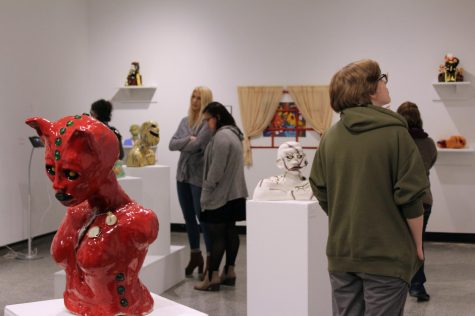
Students and community members observe artwork created for “Exquisite Cadavers & Monstrous Constructions”, a gallery made up of artwork and poetry from Winona State students to celebrate Mary Shelley’s Frankenstein, during its reception on Thursday, March 29.
“Roger Boulay and I have worked together in the past, and last year we did the opposite, I had students write poems based on the students’ projects, art muse and then at the end of the process we had a reading in the gallery where the artists got to listen to the poems read about their art,” Armstrong said. “This year we decided to take it one step further and write the poems first and then have the artists do the art.”
Armstrong’s class wrote the poems in January. The specific prompt they had to use to write their poems was monsters. Sajda Omar, a senior English-Writing major, wrote about a book.
“The prompt we got from Armstrong was ‘write a poem about monsters or monstrosity,’ and I just remembered this book I had at home that has a really disturbing cover,” Omar said. “It’s ‘Of Mice and Men,’ which is the name of the poem, but it’s an Italian version ‘Of Mice and Men’ and the cover is really gruesome-looking and basically tells you what happens at the end of the book, so that’s all I could think of. It’s just like a person’s head and then blood, but it looks kind of abstract, so you can’t really tell what it is.”
Claire Bowman, a senior literature and language major, wrote about what her idea of a monster is.
“When I think of a monster, I think of a big, hairy kind of scary thing. I didn’t want to just go directly for that, I wanted to think of something more real and I have never tried a political poem so I figured I’d try it for this one and I really don’t even remember why I picked this poem to do it but I was like ‘hey, Scott Pruitt (Administrator of the U.S. Environmental Protection Agency) is a monster’ so for the sake of being unique,” Bowman said. “I do feel really strongly about supporting our environment and making sure it’s healthy so that definitely helped me choose which politician because you know I could have written about Trump because I don’t like Trump.”
The prompt that they used helped guide their work and allowed them to think about what a monster meant to them.
“The prompt was so minimal. It allowed for a lot of fun. Armstrong was super encouraging and we all have our own monsters and we can create them however we want and it was super empowering to just be able to have an idea and then be able to run in any direction we wanted with it, so it was cool to be able to have my own kind of monster come to life, even though he already is alive and in our government,” Bowman said.
After the poems were completed, Boulay’s senior seminar class had all of February and part of March to respond to the poems with art.
Grace Hughes, a senior studio art and art history major, responded to Emma Cavanaugh’s poem “Somehow.”
“The poem was about nightmares and it reminded me of the nightmares I had when I was growing up. I had my own bedroom at my grandparents’ [house] and whenever the curtains were open, I would dream that there were monsters outside the window,” Hughes said.
Hughes created a painting of a window with monsters sitting around a table outside of it, with curtains hanging to represent her nightmare.
Bailey Britton, a senior art education major, also thought of childhood memories with the poem she had to respond to called “Ready” by Ralph Hubbard.
“The poem was about inner demons and daily struggles. It was about a child watching a scary movie and eating popcorn that has way too much butter on it,” Britton said. “Then the child gets sick and the stepfather starts to call the child names and is an actual monster.”
Britton created a ten-minute movie featuring a child watching “Stranger Things” while eating popcorn before getting sick and the inner demons come out saying the child is worthless.
Bowman shared her thoughts on Ben McCrary’s response to her poem.
“I thought [the painting] was so cool. Now that I’ve seen more of Ben [McCrary]’s work, I feel like the poem was a really cool one for him to do just because his themes in his own style of painting it seems abstract and also dark I think it kind of helped him stick to because if I would have given him a flowery, happy poem, obviously not that monsters are flowery and happy, but I think that if he would have had something like that it would have been a bit more of a challenge,” Bowman said.
Holly Al-Abad responded to Omar’s poem “Of Mice and Men.”
“She made this like ceramic skull that’s this teal, blue color and then it’s mouth is like kind of gagged with this cool red ribbon and it goes throughout the jaws I don’t know it’s just a cool way to interpret my poem in that way. I can tell what part of the poem I think she was inspired by, by looking at it,” Omar said.
The artists were given two poems by the same poet to pick from and there was still a challenge of creating art from a poem.
“It was hard because you want the piece to connect to the poem but not make it so obvious. There was one poem where the monster was within you and the artist wanted to use a mirror to show that you are your own monster, but that would be too obvious,” Hughes said.
Boulay also mentioned the class focused on the tone, an image or a metaphor that was present throughout the poem to drive their inspiration.
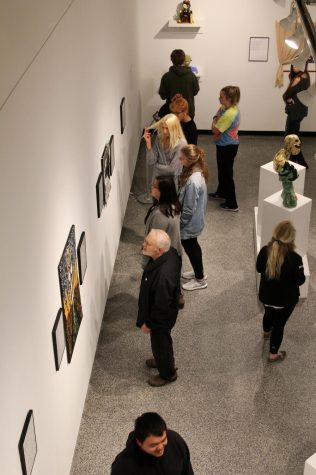
Sculptures and Poetry created by Winona State students for “Exquisite Cadavers & Monstrous Constructions” sit in Watkins Hall’s second floor gallery, Weber Gallery. The gallery celebrates Mary Shelley’s Frankenstein with corpse-esque art.
The final step to the collaboration was to bring in community poets to write a poem based off of the artists’ work.
“Roger had the idea of having a third iteration where poets would write about the art again, so we’d have poetry, art, poetry and it just so happened to coincide with the Frankenstein bicentennial, so the idea of making something out of parts was sort of Frankenstein-like,” Armstrong said.
The community poets helped bring the work full circle by bringing the artwork back to poetry.
“I think that’s a cool thing that they did. Poem, artwork and then make someone else write that. It’s like a trilogy. It’s very meta,” Omar said.
Nicolle Ramsey, Winona’s poet laureate, responded to several of the artists’ artwork, but one of her favorites was based off of the artist’s Emma Tomb’s work, which was a response to Danielle Eberhard’s poem “Vomit.”
“I remember I saw the sheet and didn’t know what to do,” Ramsey said. “Then I started using alliteration with hard ‘C’s’ and I was in Acoustic Café writing down all of the hard c’s that I know, just for this poem.”
Ramsey talked about how it was a good challenge to come up with a poem when she just had the art to focus on.
“Some of the artists explained the poem their work was based off of, but it was more what their work was based off of,” Ramsey said.
The community poets helped connect the event to the Winona community.
“It was nice to broaden the scope into the community and connect with them,” Boulay said. “Art and poetry are both under the category ‘fine art,’ but they still exist in two different words. So, to be able to connect them and bring the worlds closer together, the richer it gets and it is nice to have that seep into the community.”
The collaboration of poets, artists and poets helped create the title, “Exquisite Cadaver.”
“The reason this is called ‘Exquisite Cadaver’ is based on a surrealist technique. The surrealist technique dates back to the early 1900s and you write a line of a story then fold it over,” Boulay said. “You give it to the paper to the next person and that person writes a line and folds it over, onto the next person, and when you unfold it, you get this story that’s written that’s really weird because nobody knows what’s happening.”
Armstrong said, “This was sort of like, in some ways like that because you give somebody a poem, that person turns it into a work of art, the next person turns it into a poem, you can keep going forever.”























































